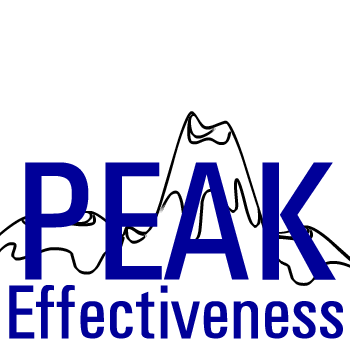






|
|
|
|
|
|
Get Engaged – At
Work and In Life!
11 Types of Effective Headlines
There are many types of headlines. Over the years copy writing pros have found several headline "formulas" that almost always work well. If you learn these formulas and apply them, your headlines will sizzle compared to the competition and get the responses you want from your customers.
1. Issue a simple command statement that includes the benefits
An imperative statement (a command, as we learned in high school English) tells the reader what to do. But to effective, couple the command with what the number one benefit of your product or service the reader will get for doing so. Turn your most important benefit into a commanding headline. Tell them specifically what they get out of it, not by just using general terms. For example:
- "Increase sales by 837% or more by next month." NOT:
- "Stop rushing through life."
- "Make more money this month."
- "Feel better about yourself."
NEED BETTER EXAMPLES
Adding the benefit to the command will be more effective than some classic headlines such as "Aim High" and "Put a tiger in your tank."
2. Start your headline with "How to."
Many of the most effective articles start with "How to." People love information that shows them how to do something they are interested in. How-To headlines are specifically good for information products, such as reports, newsletter articles, books, manuals, audio's, and videos.
Notice how often you see these headlines in web sites selling information products, and in magazines you see in the magazine racks at the grocery store. They are used because they work. You can use the words "How to" to improve your results too.
The two words "How to" carry power and punch but they are not enough by themselves. They need to be coupled with the promise of a benefit. Once again, don't forget the "what's in it for me?"
Here are some examples of businesses and the titles of the "How To" information they offer:
- Car Buying Information: "How To Buy a Car Without Getting a Lemon"
- Health Products: "How To Lose 15 Pounds In 30 Days And Keep It Off"
- Business Opportunity: "How To Find The Right Business Opportunity For You"
- Heating and Air Conditioning Service: "13 Ways You Can Cut Your Heating And Cooling Bills In Half"
- Accountant: "How To Reduce Your Income Taxes And Your Chances Of Being Audited At The Same Time" NEED BETTER EXAMPLES
There are several similar words and phrases that are inherently involving and attention grabbing and
can be used effectively in just about any headline. Such words and phrases
include:
- How To, How, Here’s
- Why, Which, Who Else, Where, When, What
- These, This, Which of These
3. Ask a question. Use "PDQ"
PDQ stands for: Preview the Problem solved around a Dominant need in the form of a Question.
Your challenge is to say something that will compel your reader to stop whatever he is thinking or doing and willingly give his entire attention to you. You must tantalize him.
The tantalizer preview should be geared to satisfying your reader's needs, solving his problem, and eliminating what is causing his problem - something that will help him gain or maintain the satisfaction of his needs. Ah.... Once again, stressing the benefits to the customer. Yes, I am a broken record, and will keep coming back to this primary concept.
Since you want him to participate in what your tantalizing words promise him, put it in the form of a question. (Not only at the beginning of a piece, but use good tantalizing sentences or questions throughout the presentation.)
A question headline gets the reader involved in your message, by the reader formulating an answer in his own mind. Many will read further to find the answer you give, to compare with theirs.
- "Are you worried about filing your tax return this year?"
- "Are you sick and tired of barely making ends meat week after week, and year after year?"
- "Have you joined dozens of business opportunities but have never received a check?"
Readers who answer the question "Yes" are going to want to read the rest of your copy to see what you have to say.
Here are some other types of questions that have been used in effective ads or articles:
This headline uses a technique in which the reader helps specify what he would value most in such a product. The copy follows through along these lines: Surely you would put this feature into it. You would be sure that it brought you this advantage -- and so on. The payoff to the ad is: "We’ve already done it all for you.""If you were given $4,000,000 to spend -- isn’t this the kind of Health Club you’d build?"
"Do You Make These Mistakes In
English?"
This is a direct challenge made provocative and
effective with the inclusion of one vital word: "these." "What
are these particular mistakes? Do I make them?" Notice also its promise to
provide the reader with helpful information.
"Do You Do Any of These Ten Embarrassing
Things?"
This question is similar to the one above as it preys
on our insecurities and makes us wonder, "Which ten are they? Do I do any
of them?" The bottom line is, "I better read and find out."
"How Much Is "Worker Tension" Costing Your
Company?"
This one uses a similar approach to the last one,
this time from a business-to-business perspective. Notice the quotation marks
around the words "worker tension." Don’t they add a certain element of
intrigue?
"Six Types of Investors -- Which Group Are You
In?"
This headline appeals to our innate
curiosity about ourselves.
These five headlines all have one very important thing in common - they are all written from one primary viewpoint: "The point of you." They all contain some version of the word "you."
4. Highlight what you are giving away Free in the headline.
"Free" offers often pull the best response. "FREE report on boosting web site sales" is a powerful way to get lots of interested prospects. There is a myth that affluent or professional customers are turned off by free offers. Not true.
Simply tailor your free offer to match the style of your customers or industry. You might subtly headline a "no-cost initial consultation" or "a bonus Widget 2000 in each package."
And, yes, again tie what they are getting free into a primary benefit!
5. Highlight your discount or special offer in the headline. Include the deadline for action.
Next to "free", people like to get "great deals" best. You can use a discount headline when you are announcing some type of sale.
When you are doing this type of headline you need to tell them:
- What type of sale you are doing.
- Why you are doing the sale. People need to know the "why" to make the deadline and the fact that the offer is really a "great deal" more believable.
- What the deadline for action is. Most of us are busy and tend to put off taking action. If you don't get the reader to act now, you may never get the sale. Deadlines encourage people to respond when their interest is highest. "Save Money Now" and "Get More If You Buy Now" offers increase response.
For example: "You can get our entire $2,495 Step-by-Step Internet training seminar for only $295 if you are one of the first twenty people to order now. We understand that many people can't afford our regular $2,495 fee for our complete course, so we are offering the entire course to twenty individuals as a national marketing test." That type of statement gives them a discount, gives them a why, and it also gives them a deadline. It does this by telling them that only 20 people are getting it and if they don't act now they aren't going to get it.
6. Provide a testimonial.
The recommendation of a satisfied customer can go a long way in convincing others to buy from you. Testimonials make the customer feel safer. "If others have been satisfied, then I am likely to be too," they think. "They say" advertising copy has substantially greater credibility and impact than "we say" advertising.
"This product really works! I'm happier and less stressed. Marina Monson-Central City."
Let your readers know that this is a real person, and not someone you just created, by including the customer's full name, and city and state they live in. Many readers won't believe a testimonial if it is hard to figure out who the author is. Which is more convincing to you? "R.O., MN" or "Rick Olson, Spicer, Minnesota" ?" (Of course it would be more powerful if I were famous.) :)))
Testimonial headlines can help your ads generate a high response. They may come from recognized experts in the industry, or they may come from rank and file customers. Stay close to your customers. Read the mail they send you. Look for a letter from someone who clearly states the benefits that they got out of your product or service. You just might find an excellent headline, from a natural and highly believable spokesperson who is similar to the target customer. These types of headlines can really produce results and be the basis for a very profitable ad campaign.
For more on Testimonials, click here.
7. Trumpet your guarantee
Guarantee headlines can be extremely effective online because people are so afraid of being ripped off on the internet. Examples:
- "Earn up to $345 daily and before lunch or your money back no questions asked."
- "100% guaranteed way to........(includes your number one benefit)."
Often your ads will be more effective if you have a 100% guaranteed at the end of the headline. List your number one benefit and then add "....(3 dots) 100% guaranteed!" Example:
"Increase your site traffic by 157%...100% Guaranteed!"
8. Announce important news.
Many effective news headlines start off with "Announcing," or "Revolutionary." These work particularly well for things that are newsworthy, such as big changes in your company, or the introduction of a hot new products or a new system of doing something. Examples:
- "Announcing a New Sure Fire 12 Step Secret System to writing sales letters that practically force people to pull out their pocketbooks and take out their money."
- "A Revolutionary new product helps you to lose 15 pounds of fat." It is giving the news.
- "Richard Benson is our new CEO with a powerful vision for the future."
- "Software Central introduces the new Instant Forms 2000--professional web site forms in 20 minutes."
Of course, what seems important to you may not be to the customer, so always include the "what's in it for me? part - the benefit the customer will receive because of the new development.
9. Problem and Solution Headline
This headline gives people a problem and a solution. Examples:
- "If you were to lose your job next week, where would your family be a month from now. Here is a 100% guaranteed way to develop a second income in only 5 hours a week."
- "If you were forced to retire tomorrow for whatever reason how would you survive. Announcing a surefire way of developing a full-time residual income at home in your spare time."
10. Particularly innovative, intriguing headlines that catch the reader's attention.
Through advertising history there have been some classic ads that have worked wonders that were very creative. There have also been some very creative ads that have absolutely bombed. This is really an art form, rarely successfully pulled off by amateurs. If you try some headlines such as these, be sure you thoroughly test them before you do a large roll-out of your advertising campaign. Examples:
The granddaddy of great advertising headlines; often imitated but rarely equaled. The headline screams "drama" - someone put down by a crowd but who overcomes against the odds. This is action oriented. We want to know what happened.They Laughed When I Sat Down At the Piano . . . But When I Started to Play!
A Little Mistake That Cost A Farmer $3,000 A Year
A highly
successful ad that ran in a number of farm magazines. The success of this
headline demonstrates that many people are much more willing to take action to
avoiding a loss than they would be to take action to gain a possible benefit.
It is human nature that
people will fight much harder to avoid losing something they already own
than to gain something of greater value they do not own. What they
have they are familiar with. It is more concrete in their minds. A
possible gain is simply a dream in their minds, perhaps only vaguely visualized,
if at all.
Another key factor in this ad’s success is the attraction of the specific. Note that it wasn’t just a mistake; it was a little mistake. What farmer could pass up reading the copy under such a headline? What farmer wouldn’t be compelled to find out: "What was the little mistake? Am I making it? If I am making it, how much could it be costing me?"
11. Combinations.
Combine the different headline types for great effect. These are only a few of the different headline formats. You can create many other kinds as well.